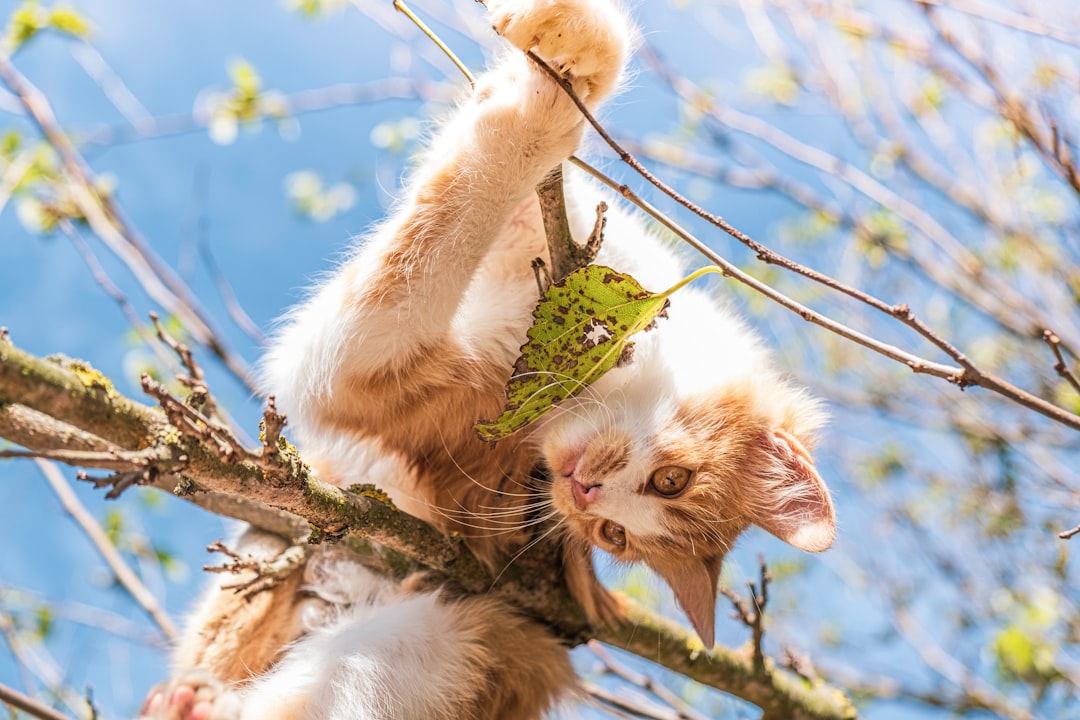In the vast, unforgiving landscapes where few creatures dare to tread, the sand cat reigns supreme. These pint-sized felines possess a remarkable set of adaptations that allow them to thrive in the arid desert environment. From their extraordinary hunting techniques to their water conservation strategies, every aspect of a sand cat’s life is a masterclass in survival. So, buckle up as we dive into the fascinating world of these resilient little hunters, uncovering the secrets behind their incredible ability to call some of the harshest habitats home.
Habitat of Sand Cats

Ah, the elusive sand cat! These whiskered wonders call the arid deserts of North Africa and Central Asia home. Let’s dig into what makes their habitat both fascinating and formidable:
- Desert Dwellers: The sand cat thrives in sandy, dry, and scrubby environments, where little vegetation means great camouflage. They’re like the ninjas of the desert!
- Burrowing Buffoons: When the scorching sun is too hot to handle, the sand cat dashes into burrows to lounge under the cool ground. Talk about smart hiding!
- Territorial Titans: Each sand cat struts around a territory that can span several square kilometers. Just imagine them as kings and queens of their sandy castles.
- Fur-tunately Adapted: Their sandy-colored fur blends seamlessly into the environment, allowing them to evade not just prey but also predators. Who knew looking fabulous could also mean outsmarting foes?
In summary, the sand cat makes its home in one of the most challenging habitats on Earth. Yet, this furry little champion turns the heat of the desert into a lifestyle!
Physical Characteristics of Sand Cats

When you think of the sand cat, picture a cute furball with some pretty impressive adaptations! These petite predators boast body features that are perfectly designed for survival in their harsh desert habitat. Here’s a closer look:
- Size: Sand cats are compact, weighing between 3 to 7 pounds and measuring about 20 inches in length. This size helps them navigate easily through tight spaces and uneven terrain.
- Fur: Their sandy-hued fur not only provides excellent camouflage against the desert landscape, but it’s also thick and insulating, protecting them from both scorching heat and chilly nights.
- Paws: The sand cat has large, furry paws adorned with soft pads. This unique design prevents them from sinking into the hot sand – think of them as natural snowshoes, but for the desert!
- Ears: The wide ears are not just for show; they enhance their hearing, allowing them to detect the slightest movements of prey hidden beneath the sand.
Clearly, the sand cat is a sassy survivalist, boasting the perfect blend of cuteness and cunning to thrive where few others can!
Hunting Techniques and Diet

When it comes to the hunt, the sand cat is a master of stealth and strategy. Living in the harsh desert, these felines possess uniquely tailored hunting techniques and a diet that keep them thriving. Here’s how they do it:
- Nocturnal Hunters: Sand cats primarily hunt at night, taking advantage of cooler temperatures and the cover of darkness. This increases their chances of catching prey while staying out of the glaring sun.
- Dedicated Diet: Their menu is quite varied, largely consisting of:
- Rodents: A favorite snack, they provide a hearty meal.
- Birds: Quick and agile, these feathered friends make for a fun chase.
- Reptiles and Insects: Mice aren’t their only musical companions; they also enjoy a crunchy side of lizard or grasshopper!
| Prey Type | Preferred Method |
|---|---|
| Rodents | Ambush and pounce |
| Birds | Stalk and leap |
| Reptiles | Quick pounce |
In summary, the sand cat combines stealth, agility, and a diverse palate to dominate the arid sands, proving that even in the most extreme conditions, ingenuity reigns supreme!
Water Conservation Strategies

When it comes to water conservation, the sand cat takes the crown. Living in arid deserts, these little furballs possess some clever tricks to stay hydrated without tapping into the water supply like some drama queen. Here’s how the sand cat pulls off its hydration heist:
- Metabolic Water Production: The sand cat cleverly converts food into water. Eating small mammals and birds not only satisfies its hunger but also releases moisture. Talk about a two-for-one deal!
- Limited Drinking: Unlike many creatures, the sand cat rarely seeks out standing water. Instead, it gets sufficient hydration from its prey, making it a master of hydration efficiency.
- Nocturnal Lifestyle: By prowling during cooler nights, the sand cat reduces the need for water by minimizing its exposure to the scorching sun. Who says you can’t be both cozy and cunning?
- Efficient Kidney Function: With a top-notch filtration system, the sand cat’s kidneys extract water from its urine, keeping it concentrated and conserving precious moisture.
In summary, with these remarkable water conservation strategies, the sand cat thrives in its harsh habitat, proving that sometimes, less is more when it comes to hydration!
Thermoregulation in Extreme Temperatures
When it comes to extreme temperatures, the sand cat proves that it’s not just surviving; it’s thriving! Living in the harsh environments of deserts, where daytime temperatures can soar to dizzying heights, the sand cat has developed some clever thermoregulation techniques.
Here’s how this feline genius keeps cool:
- Fur Insulation: The sand cat boasts a thick fur coat that insulates against both heat and cold. Think of it as a built-in climate control system!
- Nocturnal Habits: By being mostly nocturnal, the sand cat avoids the scorching sun, opting instead to hunt during the cooler nights. Talk about smart scheduling!
- Digging to Cool Off: In extreme heat, they dig burrows to escape to the relatively cooler sub-surface temperatures. They know where to find the chill!
In comparison to other desert dwellers:
| Feature | Sand Cat | Other Desert Animals |
|---|---|---|
| Fur Insulation | Thick | Varies |
| Activity Period | Nocturnal | Varies |
| Burrowing Behavior | Yes | Limited |
So, next time you think about desert survival, remember the sand cat: a master of thermoregulation!
Reproductive Adaptations
The sand cat might be small, but its reproductive strategies are impressively adaptive, perfectly suited to survive in its arid desert home. Here’s how these crafty felines keep their lineage thriving:
- Timing is Everything: Sand cats typically breed in the cooler months, from late winter to early spring. This timing ensures that their kittens have a better chance of survival when food sources are more abundant.
- Flexible Mating: Sand cats are not monogamous! Courtship consists of brief encounters, with males displaying exaggerated behaviors to attract females. Think of it as their version of a flashy Tinder profile.
- Nest Options: Unlike some larger cats, the sand cat opts for burrows and concealed dens for birthing. These safe hideaways protect their vulnerable kittens from harsh elements and predators.
- Rapid Maturity: Kittens grow fast—within a mere three months, they venture out and start developing their hunting skills. This quick maturation is crucial in the unforgiving desert, where every paw counts.
With these crafty reproductive adaptations, the sand cat proves that even in the harshest environments, cleverness can flourish!
Survival Tactics Against Predators
When it comes to staying alive in the wild, the sand cat employs some cunning survival strategies that would make even the most seasoned escapist envious. This furry little marvel, the sand cat, has adapted in several clever ways to dodge danger.
Key Survival Tactics:
- Burrowing Skills: The sand cat can swiftly dig and create underground shelters, enabling it to hide from predators like foxes or raptors. Talk about a fast getaway!
- Stealth Mode: With its sandy fur blending effortlessly into the desert landscape, the sand cat takes camouflage to the next level. It makes sneak attacks on prey feel like an episode of “Cat burglar!”
- Night Owl: This feline prefers to hunt during the cooler night hours. By being nocturnal, the sand cat avoids peak daylight, giving it an edge over daytime hunters.
- Scent Marking: To ward off rivals, the sand cat strategically uses scent marking. It’s like leaving a little note saying, “This territory is reserved. No unauthorised pouncing!”
With these innovative tactics, the sand cat proves that smart beats strong when it comes to survival. After all, in the harsh desert, it’s not just about the size of the cat; it’s about how crafty it can be!
Survival Tactics Against Predators
Ah, the sand cat—nature’s pint-sized gladiator! Despite its adorable stature, this feisty feline boasts an array of impressive survival tactics against predators that keep it thriving in harsh environments. Let’s break down some of their clever strategies:
- Stealthy Stalkers: Sand cats rely on their excellent camouflage to blend into the desert landscape, making them nearly invisible to predators. Their sandy fur acts as nature’s own sneaky cloak!
- Swift and Silent: With nimble bodies and quick reflexes, sand cats can dart away from danger faster than you can say “feline escape artist.”
- Territorial Tricks: Sand cats often use scent marking to communicate their presence, warding off larger threats by declaring that a small but fierce “no trespassing” sign is in place!
- Hide and Seek: When faced with danger, they take the game to a whole new level by burrowing in sandy dunes or hiding in the sparse vegetation. They’re the ultimate stealth creatures!
With such tactics, the sand cat remains a captivating marvel of survival in the unforgiving wilderness. Who knew such a small package could wield such big defenses?
Impact of Climate Change on Sand Cats
As the climate changes, our feisty little friend, the sand cat, faces new challenges. These adorable furballs are used to harsh desert environments, but increasing temperatures and shifting landscapes put their delicate survival skills to the test. Let’s break it down:
- Habitat Loss: With the expansion of urban areas and agriculture, sand cats find themselves squeezed into smaller territories, making it harder for them to hunt and find mates.
- Prey Depletion: As climate shifts affect local ecosystems, the availability of rodents and other prey diminishes, leaving sand cats scrambling for dinner. Bon appétit, anyone?
- Water Scarcity: These little guys are masters of water conservation, but dwindling water sources complicate their already tough lives. Even camels would take a sip or two now and then!
- Temperature Extremes: More frequent and severe temperature fluctuations may stress the sand cat’s thermoregulation abilities, leading to increased mortality rates.
In short, climate change is not just a minor inconvenience; it’s shaping the fate of the sand cat. With its adorable charm, let’s hope we can help them navigate these challenges!
Conservation Efforts and Challenges
When it comes to conserving the sand cat, these little felines face more hurdles than a racehorse at a three-ring circus. Here’s what’s being done to secure their future—and the obstacles standing in the way:
Conservation Efforts
- Protected Habitats: Establishing and maintaining wildlife reserves helps safeguard the sand cat’s natural terrain.
- Research Initiatives: Scientists study sand cat behavior and reproduction, seeking valuable insights to bolster conservation strategies.
- Community Engagement: Educating local communities about the importance of the sand cat fosters coexistence and raises awareness.
Challenges Ahead
- Habitat Loss: As human development continues to expand, the sand cat’s desert homes shrink, making it harder for them to thrive.
- Climate Change: Drastic weather changes can damage their delicate ecosystems, affecting food availability.
- Poaching and Illegal Trade: Unfortunately, sand cats become targets in the illegal pet trade, further threatening their population.
In summary, while there are promising efforts to protect the sand cat, significant challenges persist. With collective determination, we can strive to ensure that these adorable desert dwellers continue to roam the sands for generations to come!
Frequently Asked Questions
What adaptations do sand cats possess that allow them to survive in arid environments?
Sand cats have quite the survival toolkit! They feature special fur on their feet, which acts like a built-in snowshoe, allowing them to walk comfortably on hot sand without burning their little paws. Their thick fur keeps them warm in cold desert nights while their ability to go long periods without water keeps them hydrated, mostly through the moisture in their prey. They can even hear prey moving underground, making them quite the stealthy hunters in a tough environment!
How do sand cats regulate their body temperature in desert conditions?
Ah, the desert – where the sun loves to turn up the heat! Sand cats have adapted to these scorching temperatures by having a unique cooling system. They’ll often stay in their burrows during the hottest part of the day, escaping the brutal sun. At night, they can venture out to hunt while it’s a bit cooler. Furthermore, their light-colored fur reflects sunlight, helping them stay cool. Talk about being a desert diva!
What do sand cats typically eat, and how do they hunt in the wild?
Sand cats have a refined palate, dining on small rodents, reptiles, and insects that scuttle across the sandy plains. With their adorable, rounded ears, they can hear the subtle sounds of their prey; they can even hear a mouse’s heart! Their hunting strategy involves a combination of stealth and pounce, where they’ll often remain perfectly still, just waiting for the right moment to pounce like furry little ninjas. Dinner is served!
Are sand cats social animals or do they prefer solitude?
While sand cats might be cute little fluff balls, they value their personal space. These solitary felines prefer to live alone or in small family groups, maintaining a territory that can span several kilometers. Their social interactions are brief and mainly consist of mating and raising kittens. So, if you were hoping to cuddle with one, you might just have to settle for admiring from afar!



